The Japanese Footbridge
by Claude Monet
Fast Facts
- Year
- 1899
- Medium
- Oil on canvas
- Dimensions
- 81.3 × 101.6 cm (32 × 40 in)
- Location
- National Gallery of Art, Washington, DC
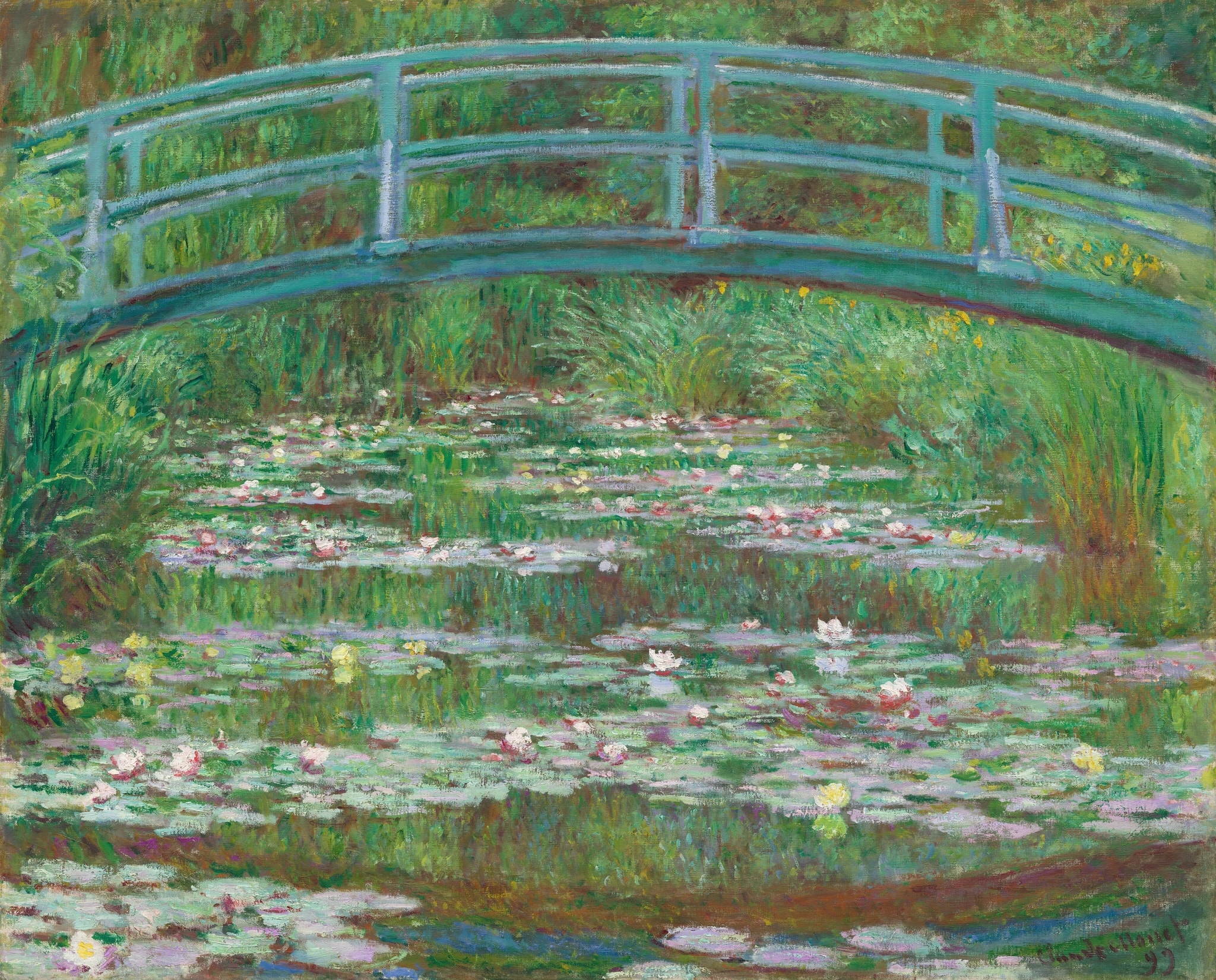
Click on any numbered symbol to learn more about its meaning
Meaning & Symbolism
The meaning of The Japanese Footbridge lies in how it transforms a tended garden into a hybrid space where East meets West and where nature becomes art through sustained looking 14. The high, cropped bridge and mirror-like water declare perception as a moving target rather than a fixed view 12. It matters because Monet converts private horticulture and Japonisme into a modern model of contemplation and seriality, proving that change—of light, weather, and season—is a viable subject for painting 13. This is why The Japanese Footbridge is important: it recasts landscape as an experiment in time, cultural encounter, and seeing.
Monet composes the canvas so that the arched bridge floats near the top edge, its pale blue-green railing slicing across a field of saturated foliage. No sky appears; instead, the pond and its lilies fill the surface, and the water’s dark mirror catches vertical streaks of grasses and willows. This arrangement asserts that what we see is not a vista but a constructed perception—a balance between horizontal lily pads and vertical reflections that unmoor the viewer from stable ground/sky hierarchies 12. The bridge’s gentle arc functions as a still center amid the flux: a symbol of passage that quietly binds two banks even as the surrounding forms dematerialize into strokes of emerald, citron, and violet. In the lower register, pink and yellow blossoms punctuate the lily field like time-stamps, registering moments of light rather than botanical inventory. Monet’s broken, layered brushwork causes edges to shimmer; the pads flare, submerge, and reappear, visualizing how sight itself shifts with each breath of breeze. The painting thus performs its thesis: seeing is temporal, and the garden exists as a sequence of sensations rather than as a stable object 12. That thesis is anchored in Monet’s own making of the place. He engineered the water garden by diverting a stream, planted “Eastern” species, and in 1895 installed a Japanese-style wooden bridge; by 1899 he worked the motif across multiple canvases from near-identical viewpoints, crafting a serial laboratory of light and season 13. Within this frame, the bridge signals a cultural hybridity: it imports the prestige of Japanese bridges from ukiyo-e into a French pastoral, a union scholars have read as East meeting West through the agency of a modern painter-gardener 46. The choice to crop the bridge and to submerge the horizon emphasizes immersion over itinerary; unlike traditional landscapes that promise distant prospects, this picture keeps the eye circling within the pond’s surface, where reflection and depth trade places. The painting asks viewers to feel duration: patches of violet shadow cool the water where reeds darken it; warmer notes of lemon and rose lift the nearer lilies; the bridge, painted with firmer, cooler strokes, steadies the eye without dictating a story. In short, the canvas elevates the act of looking to the status of subject. The broader stakes explain why The Japanese Footbridge is important. Monet fuses horticulture, Japonisme, and serial practice into a modern ethics of attention, insisting that meaning arises not from anecdote but from sustained, sensory encounter. The bridge stands as a quiet emblem of continuity across differences—Europe and Japan, cultivation and nature, solidity and flux—while the pond’s mirrored plane collapses those binaries into a single experiential field 124. As later decades would confirm in the monumental Nymphéas and the late, nearly abstract bridge canvases, this 1899 conception inaugurates a path toward twentieth-century abstraction by treating the canvas as a screen of light, color, and time rather than a window onto narrative space 15. Here, the short, vibrating strokes do more than describe lilies; they model how attention can bridge worlds, joining the viewer to the living moment that the painting both records and recreates.Citations
- National Gallery of Art (Washington), The Japanese Footbridge (1899) – object page and essay
- National Gallery (London), The Water-Lily Pond (1899) – object page
- Princeton University Art Museum, Water Lilies and Japanese Bridge (1899) – handbook text
- Christies scholarly entry (citing Wildenstein; Paul Hayes Tucker on hybridity)
- MoMA, The Japanese Footbridge (c.1920–22) – object record and curator audio
- Fondation Monet / Princeton Art Museum – Monet’s Japanese prints; Bridges in Japanese art (Japonisme context)
Explore Deeper with AI
Ask questions about The Japanese Footbridge
Popular questions:
Powered by AI • Get instant insights about this artwork
Interpretations
Historical Context
Source: National Gallery of Art; National Gallery, London; Princeton University Art Museum; Christies (citing Wildenstein/Tucker)
Formal Analysis
Source: National Gallery of Art; National Gallery, London; MoMA
Symbolic Reading
Source: Princeton University Art Museum; National Gallery of Art; Christies (Paul Hayes Tucker)
Psychological Interpretation
Source: National Gallery, London; National Gallery of Art
Social Commentary
Source: National Gallery of Art; Princeton University Art Museum (Japonisme/bridges)
Reception History
Source: National Gallery, London; Christies (Wildenstein/Tucker); MoMA
Related Themes
About Claude Monet
More by Claude Monet

Haystacks Series by Claude Monet | Light, Time & Atmosphere
Claude Monet
Claude Monet’s <strong>Haystacks Series</strong> transforms a routine rural subject into an inquiry into <strong>light, time, and perception</strong>. In this sunset view, the stacks swell at the left while the sun burns through the gap, making the field shimmer with <strong>apricot, lilac, and blue</strong> vibrations.

The Artist's Garden at Giverny
Claude Monet (1900)
In The Artist's Garden at Giverny, Claude Monet turns his cultivated Clos Normand into a field of living color, where bands of violet <strong>irises</strong> surge toward a narrow, rose‑colored path. Broken, flickering strokes let greens, purples, and pinks mix optically so that light seems to tremble across the scene, while lilac‑toned tree trunks rhythmically guide the gaze inward <sup>[1]</sup><sup>[3]</sup>.
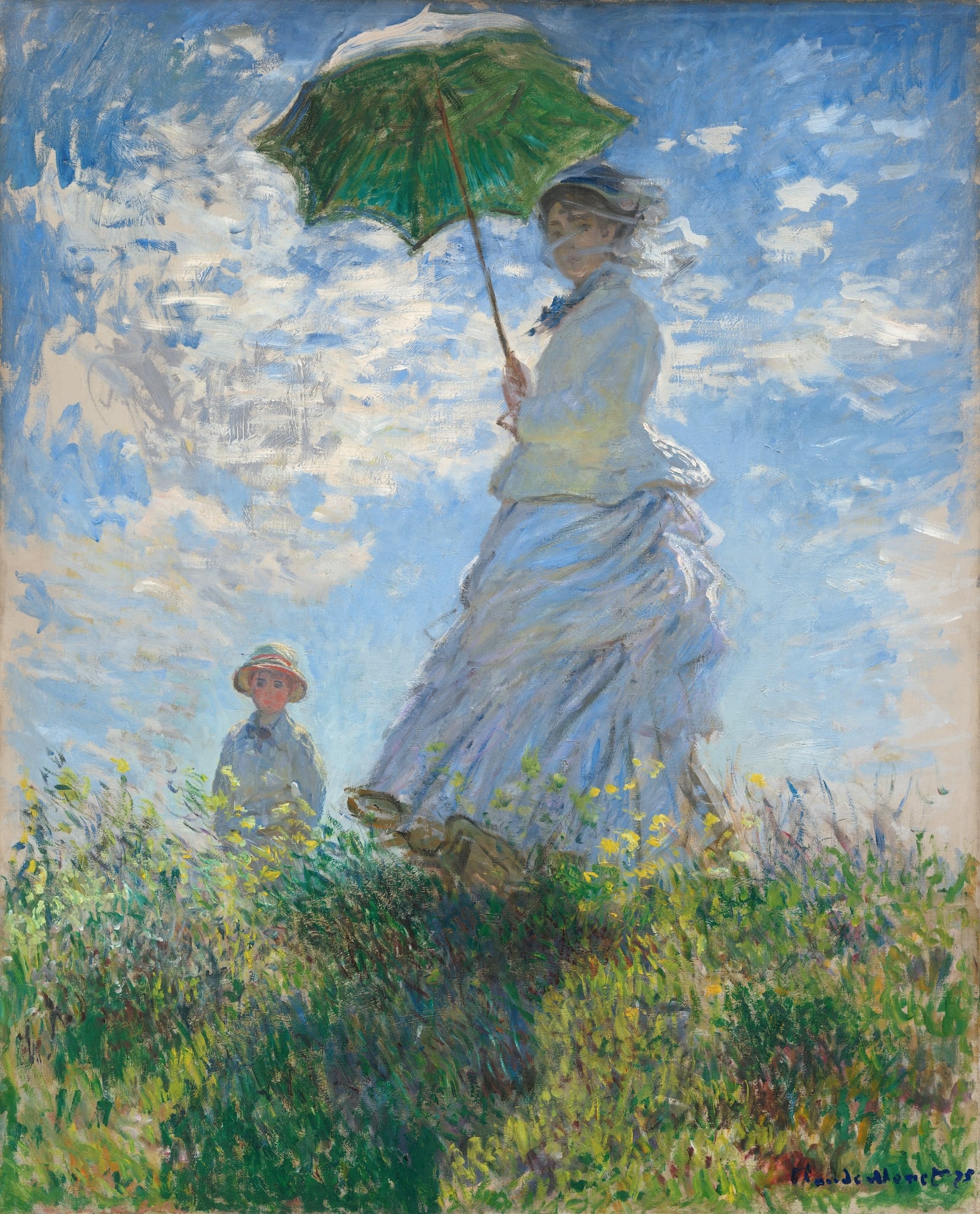
Woman with a Parasol
Claude Monet (1875)
Claude Monet’s Woman with a Parasol fixes a breezy hillside instant in high, shifting light, setting a figure beneath a <strong>green parasol</strong> against a vast, vibrating sky. The low vantage and <strong>broken brushwork</strong> merge dress, clouds, and grasses into one atmosphere, while a child at the rise anchors depth and intimacy <sup>[1]</sup>. It is a manifesto of <strong>plein-air</strong> perception—painting the sensation of air in motion rather than the contours of things <sup>[2]</sup>.
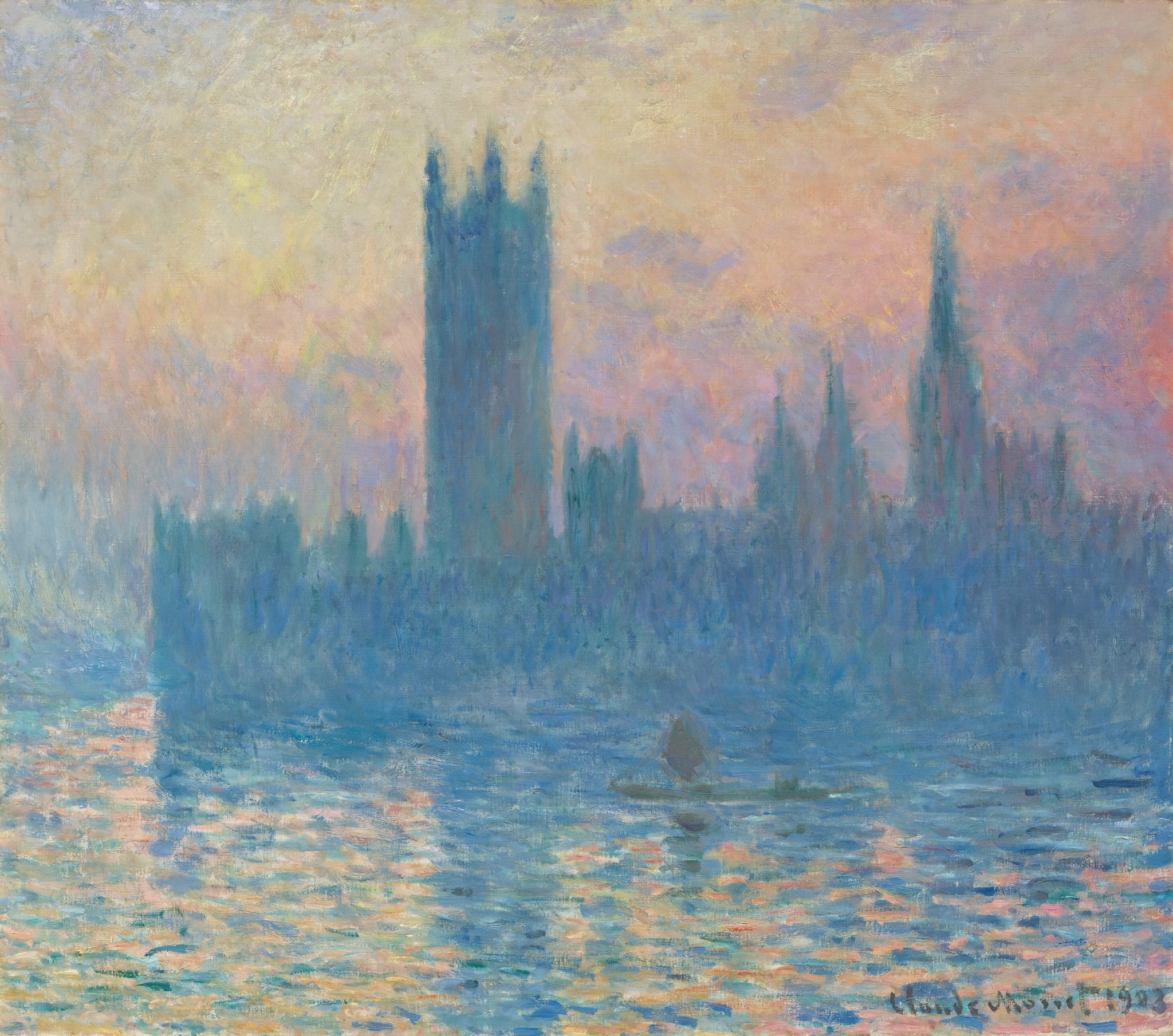
Houses of Parliament
Claude Monet (1903)
Claude Monet’s Houses of Parliament renders Westminster as a <strong>dissolving silhouette</strong> in a wash of peach, mauve, and pale gold, where stone and river are leveled by <strong>luminous fog</strong>. Short, vibrating strokes turn architecture into <strong>atmosphere</strong>, while a tiny boat anchors human scale amid the monumental scene.
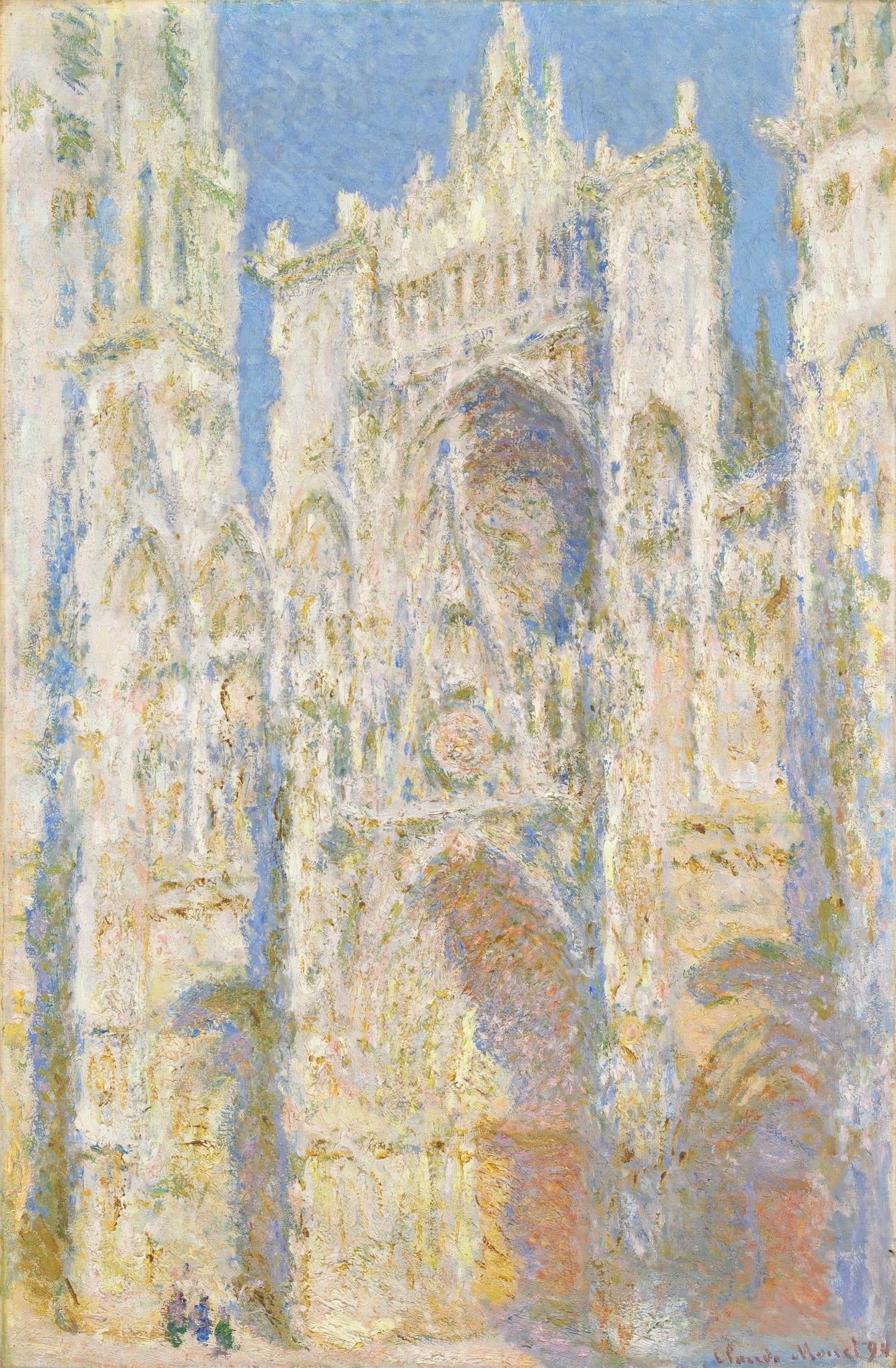
Rouen Cathedral Series
Claude Monet (1894)
Claude Monet’s Rouen Cathedral Series (1892–94) turns a Gothic monument into a laboratory of <strong>light, time, and perception</strong>. In this sunstruck façade, portals, gables, and a warm, orange-tinged rose window flicker in pearly violets and buttery yellows against a crystalline blue sky, while tiny figures at the base anchor the scale. The painting insists that <strong>light—not stone—is the true subject</strong> <sup>[1]</sup><sup>[2]</sup>.
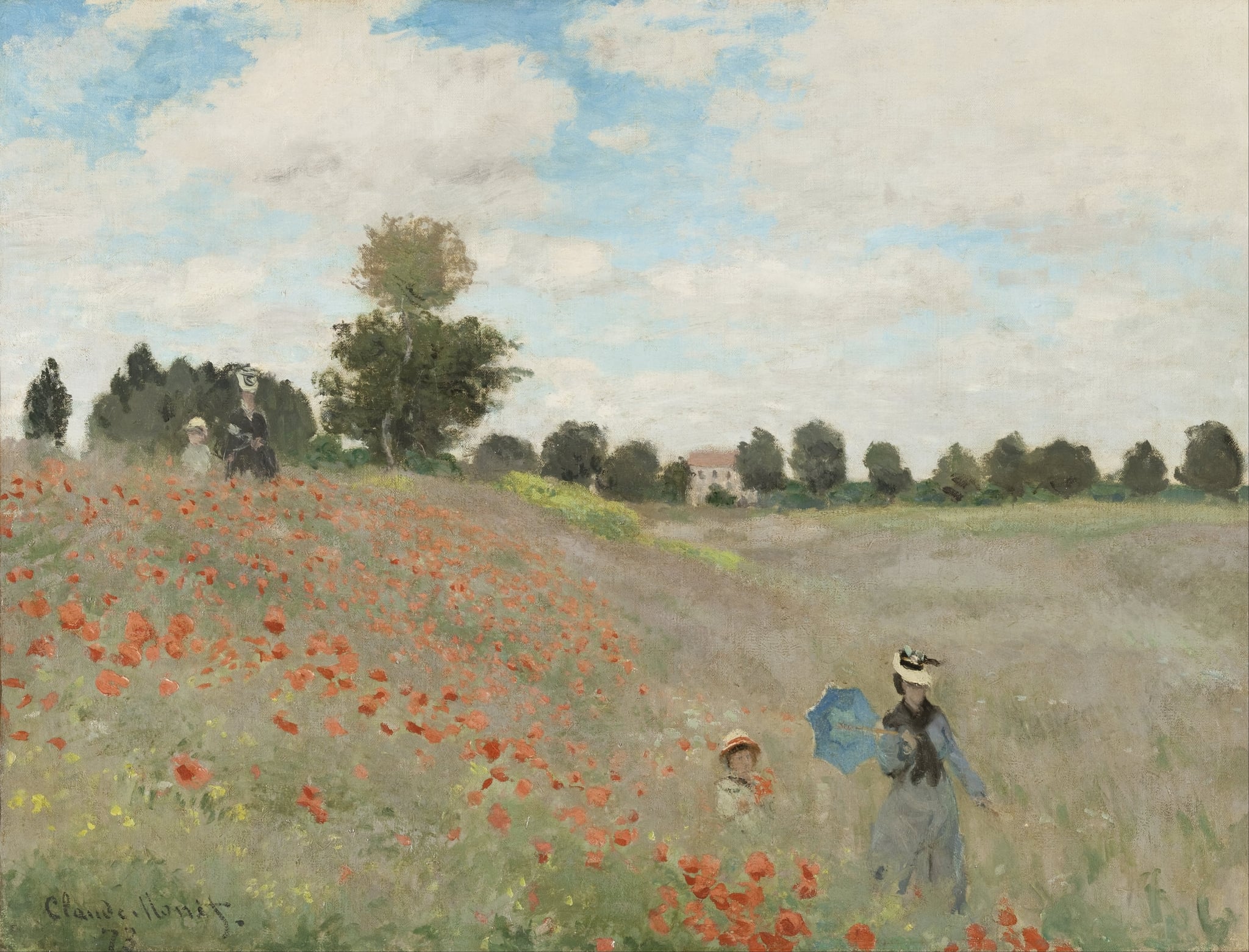
Poppies
Claude Monet (1873)
Claude Monet’s Poppies (1873) turns a suburban hillside into a theater of <strong>light, time, and modern leisure</strong>. A red diagonal of poppies counters cool fields and sky, while a woman with a <strong>blue parasol</strong> and a child appear twice along the slope, staging a gentle <strong>echo of moments</strong> rather than a single event <sup>[1]</sup>. The painting asserts sensation over contour, letting broken touches make the day itself the subject.